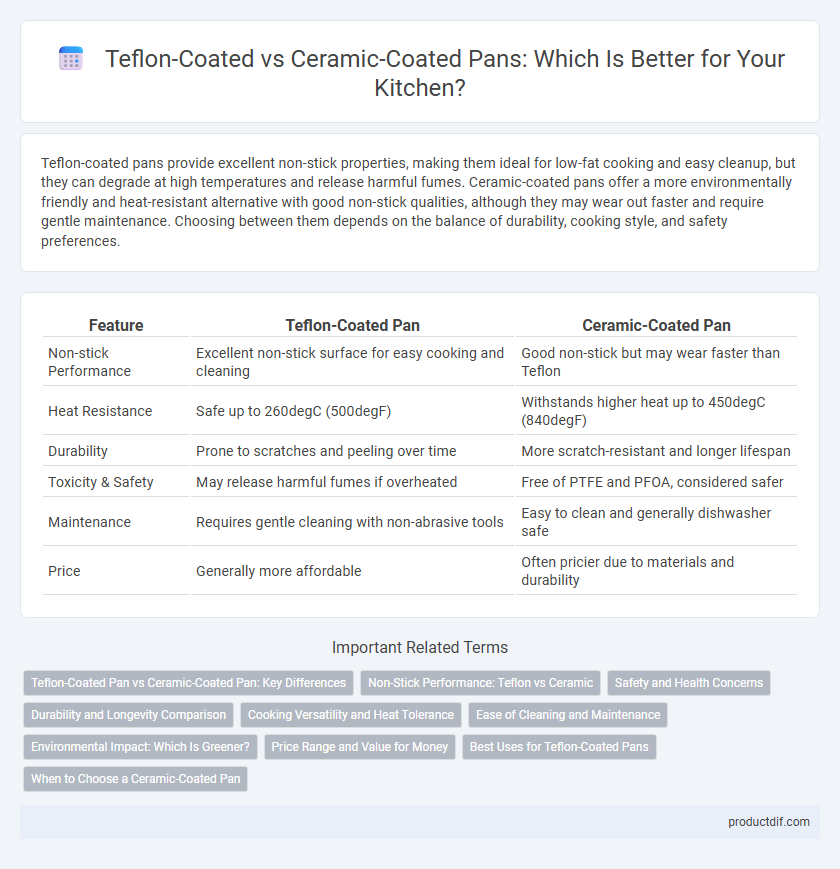Teflon-coated pans provide excellent non-stick properties, making them ideal for low-fat cooking and easy cleanup, but they can degrade at high temperatures and release harmful fumes. Ceramic-coated pans offer a more environmentally friendly and heat-resistant alternative with good non-stick qualities, although they may wear out faster and require gentle maintenance. Choosing between them depends on the balance of durability, cooking style, and safety preferences.
Table of Comparison
| Feature | Teflon-Coated Pan | Ceramic-Coated Pan |
|---|---|---|
| Non-stick Performance | Excellent non-stick surface for easy cooking and cleaning | Good non-stick but may wear faster than Teflon |
| Heat Resistance | Safe up to 260degC (500degF) | Withstands higher heat up to 450degC (840degF) |
| Durability | Prone to scratches and peeling over time | More scratch-resistant and longer lifespan |
| Toxicity & Safety | May release harmful fumes if overheated | Free of PTFE and PFOA, considered safer |
| Maintenance | Requires gentle cleaning with non-abrasive tools | Easy to clean and generally dishwasher safe |
| Price | Generally more affordable | Often pricier due to materials and durability |
Teflon-Coated Pan vs Ceramic-Coated Pan: Key Differences
Teflon-coated pans feature a synthetic polymer non-stick surface known for excellent food release and easy cleaning, while ceramic-coated pans utilize a silica-based coating that offers higher heat resistance and is free from PTFE and PFOA chemicals. Teflon pans generally provide smoother cooking experience but may degrade at temperatures above 500degF, whereas ceramic pans withstand higher temperatures but can be more prone to chipping and reduced non-stick performance over time. Choosing between the two depends on priorities like durability, heat tolerance, and chemical safety preferences in kitchenware.
Non-Stick Performance: Teflon vs Ceramic
Teflon-coated pans offer superior non-stick performance with effortless food release and easy cleaning, ideal for low to medium heat cooking. Ceramic-coated pans provide a natural non-stick surface but may lose effectiveness faster due to wear and higher heat sensitivity. Both options reduce the need for cooking oil, enhancing healthier meal preparation.
Safety and Health Concerns
Teflon-coated pans contain polytetrafluoroethylene (PTFE), which can release toxic fumes at temperatures above 500degF (260degC), posing health risks such as polymer fume fever. Ceramic-coated pans are free from PTFE and PFOA, offering a non-toxic alternative with greater heat tolerance and reduced risk of chemical exposure. Choosing ceramic-coated cookware enhances kitchen safety by minimizing harmful emissions and ensuring healthier cooking environments.
Durability and Longevity Comparison
Teflon-coated pans typically offer high durability with a non-stick surface that can withstand moderate heat and regular use but may degrade faster when exposed to metal utensils or abrasive cleaning. Ceramic-coated pans provide excellent scratch resistance and maintain non-stick properties longer under high-heat cooking but may chip or crack if mishandled. Overall, ceramic-coated pans often deliver superior longevity in daily kitchen use compared to Teflon-coated alternatives.
Cooking Versatility and Heat Tolerance
Teflon-coated pans offer superior non-stick properties ideal for low to medium heat cooking, making them perfect for delicate foods like eggs and pancakes but less suited for high-temperature searing. Ceramic-coated pans withstand higher heat levels, allowing for versatile cooking methods including sauteing, frying, and browning without the risk of coating degradation. The heat tolerance of ceramic coatings extends durability and cooking flexibility, whereas Teflon pans require careful heat management to maintain their performance and safety.
Ease of Cleaning and Maintenance
Teflon-coated pans feature a smooth, non-stick surface that allows food residues to slide off easily, making cleaning quick and requiring minimal scrubbing. Ceramic-coated pans resist staining and can handle higher temperatures, but may need more careful washing with non-abrasive sponges to preserve the coating. Both types avoid the need for heavy-duty cleaners, yet Teflon pans generally demand less maintenance due to their superior non-stick properties.
Environmental Impact: Which Is Greener?
Teflon-coated pans contain polytetrafluoroethylene (PTFE), which can release harmful fumes when overheated and pose environmental hazards during manufacturing and disposal due to persistent chemical compounds. Ceramic-coated pans are made from inorganic materials that are generally considered more eco-friendly, as they lack toxic chemicals and break down more easily without releasing pollutants. Choosing ceramic-coated pans can reduce environmental impact through safer production processes and improved biodegradability.
Price Range and Value for Money
Teflon-coated pans typically range from $15 to $50, offering affordability and excellent non-stick performance for everyday cooking. Ceramic-coated pans, priced between $30 and $70, provide a chemical-free, eco-friendly alternative with better heat resistance but may require more careful maintenance. When considering value for money, Teflon pans are ideal for budget-conscious buyers, while ceramic pans appeal to those prioritizing durability and health benefits despite a higher initial cost.
Best Uses for Teflon-Coated Pans
Teflon-coated pans excel in low to medium-heat cooking such as sauteing vegetables, frying eggs, and preparing delicate fish, thanks to their superior non-stick surface that requires minimal oil. They offer easy food release and quick cleanup, making them ideal for everyday use and recipes needing gentle heat to preserve texture and flavor. Their lightweight design enhances maneuverability, perfect for tasks like flipping pancakes or cooking omelets without sticking.
When to Choose a Ceramic-Coated Pan
Choose a ceramic-coated pan when you prioritize non-toxic, eco-friendly cooking surfaces that resist scratching and high heat better than Teflon coatings. Ideal for searing, sauteing, and frying at temperatures exceeding 450degF without compromising non-stick performance. Ceramic pans are also preferred for durability and maintaining food flavor without the risk of chemical release from traditional non-stick layers.
Teflon-Coated Pan vs Ceramic-Coated Pan Infographic

 productdif.com
productdif.com